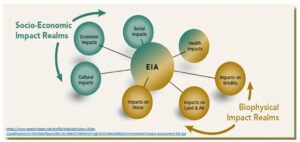Back to: Environmental Biology 500 Level
Welcome to class!
Hello again, my thoughtful learner! I’m so happy you’re here today. You’ve been learning powerful tools that protect our environment, and now we’re going even deeper. Today’s topic is Environmental and Social Impact Assessment (ESIA)—a process that not only considers the land, water, and air, but also the people, culture, and daily lives connected to any development. After all, every project affects both the environment and the people living in it. So, let’s talk about how ESIA helps us build responsibly, with people and nature in mind.
Environmental And Social Impact Assessment (ESIA)
What is Environmental and Social Impact Assessment (ESIA)?

ESIA is a process that assesses both the environmental and social consequences of a proposed project—before it starts. It combines the Environmental Impact Assessment (EIA), which focuses on nature, with Social Impact Assessment (SIA), which focuses on human life and community wellbeing.
In simple terms, ESIA asks:
“What will this project do to the environment?”
“How will it affect the people living nearby—their jobs, culture, safety, and lifestyle?”
It helps developers, governments, and communities make informed decisions that avoid harm and support long-term benefits.
Why is ESIA Important?
Protects Human Rights and Livelihoods
Many projects—like dams, highways, or mining—may require people to move or may affect their farms, schools, markets, or health. ESIA ensures these impacts are identified early and managed fairly.
Promotes Community Involvement
ESIA gives communities a voice. Their ideas, fears, and knowledge guide better decisions and reduce future conflicts.
Ensures Environmental Sustainability
Like EIA, it checks air, water, land, biodiversity, and natural resources to avoid long-term damage.
Improves Project Design
Developers can adjust plans to reduce risks and increase benefits to both nature and society.
Key Components of ESIA
Project Description – What the project is about and where it will take place.
Baseline Studies – What is the current condition of the environment and people in the area?
Impact Prediction – What environmental and social changes are likely to happen?
Mitigation Measures – How can we reduce or prevent the negative impacts?
Public Participation – Engaging local communities, traditional rulers, and stakeholders to share their views.
Environmental and Social Management Plan (ESMP) – A detailed plan for managing impacts during and after the project.

Example from Nigeria:
Before the construction of the Mambilla Hydropower Project in Taraba State, ESIA was conducted. It revealed that the project would affect farmland, wildlife, and several local communities. As a result, proper relocation plans and compensation packages were included in the project design to reduce harm.
Summary
- ESIA stands for Environmental and Social Impact Assessment.
- It combines environmental and social analysis before a project begins.
- ESIA helps protect both nature and people, ensures fairness, and improves project planning.
- It includes community voices and leads to more sustainable development.
Evaluation
- What is the full meaning of ESIA?
- Mention two ways ESIA benefits local communities.
- List three components that must be included in an ESIA report.
- Give one example of a Nigerian project that required ESIA and why.
You’re doing fantastic, and your understanding keeps growing stronger with each lesson. By learning about ESIA, you’re preparing to help build a Nigeria where development respects both the environment and the people. Keep it up—Afrilearn is proud to walk this journey with you. See you in the next class, changemaker!
